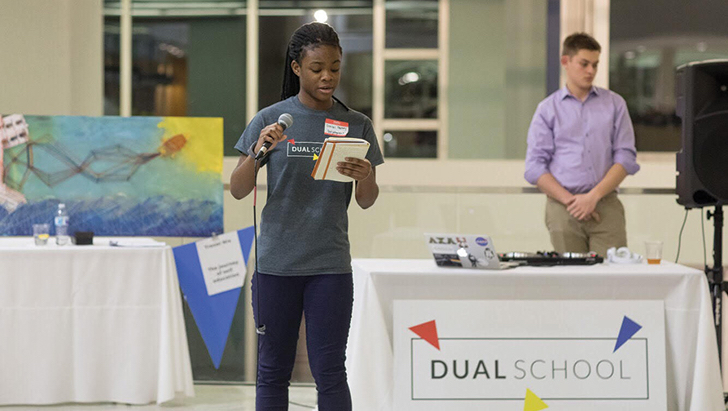A network is defined as a group or system of interconnected people or things.
When I first heard of networks and networking, I did not picture a collaborative space of innovation. I thought it was some complex idea only adults could understand.
I failed to recognize that I have been networking my whole life. I learned the simple things like how to make a new friend or talk about what we were doing in class when I was younger, but not how to ask real questions.
Of course, younger me did not know how to hold a professional conversation, but my experiences in high school afforded me with increased knowledge about the complexities of networks and networking. My definition of networking has come to be the recognition of an environment and the possibilities of those engaged in conversation.
My first network was the Dual School space, an out-of-school student incubator for ideas that got its start in the spring of my sophomore year in the coworking space 1313 innovation. (One local school does operate Dual School during class time.) I attended a prototyping session over the summer then eagerly applied later in the fall and was overjoyed when I heard of my acceptance, eventually participating from September 2017 to January 2018.
Dual School challenges the typical school experience by encouraging hard- and soft-skill development in coding, critical thinking, program design, project management and entrepreneurship. Used to a traditional classroom structure and following the same routine, I found the environment to be truly transformative. It introduces a new idea of rapid prototyping and exchanging ideas and building a network.
The recognition of community resources and partnerships are what propel innovation and create the potential to advance our world.
My participation in this program made me also realize the distinctions between a personal network and a professional one. It provided a safe space for idea generation, feedback and collaboration. In the first few weeks, I was assigned a mentor and later tasked to create a personal advisory board. The magic of networking in action, I talked to the mentors, directors and friends of the community in efforts to propel my project forward. Most of the people who were on my advisory board later were from the connections in the Dual School network.
I asked Dual School Director Zack Jones to share his ideology of networking with myself and the students of Cohort One, namely what to look for in joining a network:
“I would say it depends on what stage of your career or involvement in an industry is,” Jones said. “I’m always looking for people to fit when identifying new networks. I’m looking for people who have a similar mindset in the sense that they’re passionate, generous and curious.”
Though the program, I learned more about creative processes and how to activate the imagination side of my brain. During the final presentation of our projects — the exhibition night — I practiced the skills I learned over the 10-week program while presenting my project geared toward eliminating prejudgement in high schools. Among business leaders, school administrators and prospective students, the night boasted of the successes of Dual School’s Cohort One.
Since Dual School, my network has expanded into the technological, governmental and entrepreneurial spheres. From the Great Dames community to the one I’ve created through the Student Leadership Initiative Program (SLIP), I believe networks are essential to growth. The recognition of community resources and partnerships are what propel innovation and create the potential to advance our world.







